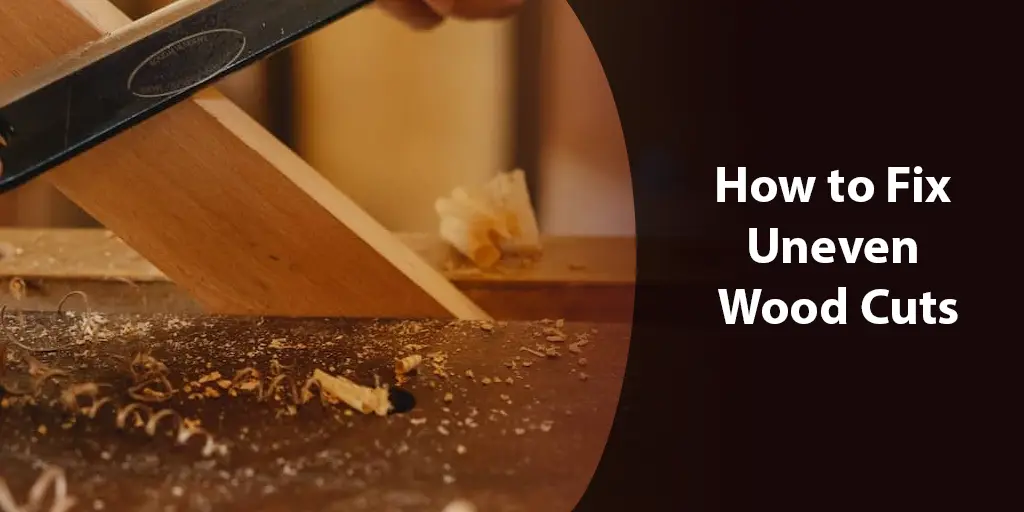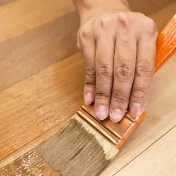Whether you’re a seasoned woodworking professional or just starting your craft, proper technique is essential for accurate cuts every time. Uneven surfaces can ruin the look of your project and potentially weaken structural integrity.

As a trusted resource for woodworkers, let me share some insights on identifying and fixing uneven wood cuts.
We’ll start with the importance of precision cutting. You’ve no doubt experienced the frustration of pieces that don’t fit together smoothly due to uneven edges. This can waste time and material as you work to correct mistakes.
Accuracy is key to efficiently completing projects on budget and to the highest standards. I’ll outline the most common causes of inaccurate cuts and how to prevent them.
Next, I’ll show you how to examine wood surfaces and determine the severity of unevenness. Understanding the problem is half the solution. We’ll explore various types of imperfections and which corrective methods work best in each case.
You’ll learn hands-on techniques using essential tools like planes, chisels and sanders for minor issues and powered machinery for larger repairs.
Safety is a top priority in any woodworking situation. I’ll provide guidance for setting up a properly calibrated workspace and handling equipment safely.
Finally, I’ll answer frequently asked questions so you can fix uneven cuts with confidence, giving your creations a flawless finish every time. Let’s get started improving your precision cutting skills.
Identifying Uneven Wood Cuts
The first step in correcting uneven surfaces is recognizing when a cut goes awry. As an experienced woodworker, I can assure you it’s usually quite clear whether a cut is accurate or imperfect. Let’s examine some of the key signs that indicate unevenness:
One obvious visual cue is an edge that doesn’t appear straight and true. You may see portions that are thicker or thinner than the rest of the cut.
Surfaces that should be flat may dip or bulge in areas. Hold a straightedge up to the wood – it will rock or gap over uneven segments.
You can also detect inconsistencies by running your hand along the grain. Smooth surfaces will feel uniform under your touch while imperfect edges will catch or skip in spots.
Gently gliding a finger back and forth reveals any unevenness in the cuts.
Listen closely too. Dragging a fingernail lightly across a cut may produce a scratching sound at the problem areas. Conversely, a perfectly flush surface will make only a subtle sound.
Some common factors responsible for uneven cuts include dull or damaged blades, poorly calibrated saws and machinery, unexpected knots or grain patterns in the wood, and weak clamping technique. Understanding why inaccuracies occur helps avoid these issues in the future.
With practice, your inspection skills will sharpen. Identifying problems quickly is the first move toward crafting flawless finishes every time. Let’s now explore strategies for fixing uneven wood.
Essential Tools for Fixing Uneven Wood Cuts
When it comes to correcting uneven surfaces, having the right tools for the job makes all the difference. As an expert in woodworking, let me share my insight on essential equipment for precision repairs.
No woodworker’s kit is complete without a selection of high-quality sandpaper in a range of grits. For minor imperfections, start with a medium grit like 120 to smooth edges without removing too much material. Work your way up through finer grits for buttery smooth finishes.
Planes are indispensable as well. Whether a hand plane, block plane or jointer, these long-lasting tools create perfectly even surfaces with ease. Look for a solid construction and keep blades razor sharp.
For targeted material removal, carving tools like chisels and files are your friends. Different blade profiles allow precise contouring and shaping with control. Always use a honed edge and go with the grain.
A power planer or thickness sander can remove wood quickly when imperfections are more severe. Just be careful not to overwork the material. I also recommend a detail sander or random orbit sander for hard to reach spots.
With the right blades and saws aligned properly, you can recut imperfect sections cleanly. Keep your table saw, band saw and circular saw well-tuned for safety and clean cuts.
Does this overview help explain why certain tools belong in every woodworker’s arsenal? Let’s keep moving forward to methods for using them to their full potential.
Preparing Your Workstation
A properly organized workshop is key to executing any woodworking project with optimal results. As an industry expert, allow me to provide some valuable guidance on workstation preparation.
First, evaluate your space and remove any potential hazards or clutter that could cause unsafe situations. A well-lit, dust-free area keeps you focused on the task.
Assess the condition of your tools as well – make repairs or adjustments before beginning a job. Confirm moving parts operate smoothly and blades are freshly sharpened. An inspection takes minutes but ensures precision.
Consider also how you can best position your machinery. Layout options that allow efficient material flow without cramped quarters. Distances should feel comfortable to reduce fatigue.
Accuracy demands vibration-free surfaces. A sturdy worktable isolated from the building foundation provides a stable reference point. Use hold-down clamps where needed to eliminate play.
Calibration is key. Square machines, set parallel fences and test blade/cutter alignment before use. Micro adjustments make a massive difference in cut quality.
With your assembly process and tool stations configured logically, unnecessary steps disappear. Preparing your space in this way promotes safety, efficiency and flawless results every time. Laser focus on the work becomes the only remaining task.
Assessing the Severity of Uneven Cuts
Properly diagnosing the extent of an uneven cut is an important preliminary step when planning your repair strategy. As an experienced woodworker, let me offer some valuable insights into evaluation.
Start your examination under bright, shadow-free lighting to accurately gauge imperfections. Move the wood at various angles to better detect subtle deviations in the surface.
Use a straightedge and depth gauge to quantify any unevenness. Note the widest gaps or dips to determine the degree of inaccuracy across the board. Document findings for future reference.
Classifying issues will help select the appropriate remediation approach. Areproblem areas minor and localized or more significant? Are edges merely burnished or severely skewed? Distinguishing severity types ensures choosing methods that avoid unnecessary rework.
Another assessment factor is the cut’s structural role in a design. Aesthetic flaws may be less critical on non-load bearing sections versus substrate on which other joins rely. Consider functionality early on.
With experience, your eye for imperfections sharpens tremendously. But maintaining methodical habits now establishes proficiency that serves you for years to come. Detailed evaluation sets the stage for fixing cuts reliably every time.
Fixing Minor Uneven Wood Cuts
For small imperfections, simple methods often do the trick. As an expert craftsman, I recommend starting with light sanding techniques that balance effectiveness with material preservation.
Begin with a sanding block and medium-grit paper to burnish uneven edges without removing a lot of material. Work in the direction of the grain and inspect frequently – just smoothing, not shaping.
Once level, move up gradually through finer grits for an ultra-smooth finish, like 150, 180, then 220. This sequential progression helps eliminate swirl marks between each step.
For delicate surfaces, try a foam sanding pad or soft cloth backed abrasives. Both eliminate the risk of gouging while polishing flushes edges with control. just apply gentle, even pressure.
Should thicker sections require planing, make successive passes testing flatness until true. Go with the grain to avoid furrows. A high-quality block plane works wonders on small patches.
Fillers like wood putty are perfect for barely recessed spots. Sand smooth when set for an invisible fix. Primer helps camouflage any shadows.
With practice, you’ll quickly resolve minor flaws. Always aim for a balance of thoroughness and minimal material removal. Refined skills yield pristine results with ease.
Remediating Moderate Uneven Wood Cuts
For more pronounced unevenness, step up your techniques while still preserving as much wood as sensibly possible. As an industry veteran, here are my suggested strategies for moderate imperfections.
Hand planes promote consistent material removal right where needed. A jack plane creates flat surfaces while a jointer achieves straight edges when executed with precise, overlapping strokes against the grain.
Pair your planes with a sharp card scraper to further smooth and level edges in tight spaces. Lightly applying firm pressure yields professional results.
Precision carving tools like chisels and files shape contours with finesse when guided by an experienced hand. Make microscopic curls instead of gouges by following grain flow.
A belt or disc sander offers a powered option. With their ergonomic design, you can maintain optimal control and angle. Always use the appropriate grit sequence and avoid overheating the wood.
Rotary tools, powered by hand or machine, remove wood economically without heavy labor. Quality bits keep cuts uniform while shielding minimizes splintering.
With diligent practice of these techniques, flawlessly even wood becomes the new standard. Your growing mastery yields consistent, professional outcomes every time.
Remedying Significant Uneven Wood Cuts
For serious unevenness, it’s time to deploy heavier duty machinery. As an industry leader, I recommend approaches that reconstruct surfaces seamlessly and set you up for long-lasting success.
Table saws and band saws enable clean removal of excess material down to the true line when combined with appropriate jigs or miter gauges. Take setup time for maximum safety and accuracy.
Thickness planers reconstitute badly gouged sections by gradually Leveling thick areas to the desired consistent dimension. Joint one face then plane subsequent sides for dead-flat squareness.
Wide belt or drum sanders make light work of substantial stock removal for a smooth, consistent refinish. Go with the grain using progressively finer abrasives to ideal smoothness.
Epoxy compounds rescue seriously imperfect cuts by bonding reconstituted strips or shims. With flawless bonds and meticulous finishing, the repair is virtually invisible.
These heavy-hitting methods may seem aggressive but sometimes rework demands an industrial touch. By judiciously employing machinery integrated with hand skills, you can salvage even the most troubled wood to perfect as-new condition.
Mastering Precision Cutting Techniques
Taking cuts to the highest level requires honing specialized strategies. As a woodworking authority, I want to impart some invaluable expertise on refined methods.
Table saws excel when rigged with sinply-made auxiliary fences that constrain material flow for repeatable crosscuts. Sacrificial boards also protect blades from burn-in.
With band saws, blades must run true and parallel guides keep stock steady. Backing sheets catch tear-out. For tight radii, reduce speed and engage the lower blade guides.
Edge jointing demands a jointer and planer set up for joint snug siding. Joint one edge first before thickness planing subsequent faces square and crisp.
Routers equipped with tapered template bits rout duplicated compound contours onto blanks with robotic precision. Jigs affix templates for zero-play passes.
Laser cutters continue router template roles on their high-def plains with sharper, more scalable options. Engravers precisely place repetitive patterns too.
Whether refining cuts by hand or machine, perfection stems from mastery of staging, holding workpieces and controlling variables. Constant refinement elevates results over the long haul.
Essential Techniques for a Fine Finish
No project is complete without an exquisitely smooth surface. As a woodworking expert, I’m eager to impart invaluable advice regarding top finish results.
Always sand with the grain, using a sequence of increasingly finer grits to remove scratches from previous paper. 150 to 220-grit gets you mirror-smooth once completed.
For a brilliant satin sheen, hand-sand with 400-grit wet/dry paper. Progress to micro-abrasives like 000 steel wool or fine pumice if desired. Rubbing out pesky swirls yields lacquer-like luster.
When staining woods, first seal end grain to block absorbency inconsistencies. Wipe on and wipe off color evenly in the direction of fiber lines to ensure uniform hue.
French polishing with pumice and oil rejuvenates antique marks while imparting a hand-rubbed patina. Microcrystalline wax secures this naturally rich look attained only through dedication and care.
Let dry time be your friend – allow finishes to fully cure before assembly or handing. Slowly built coats prevent runs or flaws. Hardwax oils form durable beauty given sufficient drying periods.
With focus on surface perfection, even the most challenging imperfections fade away. Your finely honed technique takes any project to a new standard of wow.
Achieving Precision On Complex Projects
While fundamentals apply, compound projects require amplified expertise. As a seasoned professional, here are my strategies for precise results even on challenging designs.
Custom jigs reproduce exact components quickly by semiautomating subsequent cuts. Edge-glue blanks then flush trim with a bit centered in a jig’s offset runners.
For slab furniture, use a track saw’s exact kerf to slice parts list repeats effortlessly. Trusty push pads guide blades on long straight runs.
Multi-axis CNC routers carve repeating textures, tricks and details into blanks using G-code programs. Waterjet cutters slice intricate parts from sheet stock too.
Where manual shaping remains, form rigid templates to uniformly rout profiles onto stock. Chisel-brushed templates maintain dimensional integrity.
Panelized constructions employ intermediate cauls to facilitate accurate face-gluing of abutting sections prior to final assembly glue-ups.
By methodizing complex builds and optimizing jigs, even non-standard forms emerge flawlessly calibrated. Refined specialization sets my work apart.
Adopting these most evolved techniques isn’t to impress, but to fulfill even the most demanding design visions perfectly through robust, industrial solutions. Excellence is the only goal.
Skillful Troubleshooting for Continuous Improvement
Even for professionals, issues occasionally arise. The true sign of mastery lies in how intelligently you diagnose and learn from mistakes. As an expert consultant, here’s my approach:
Begin by carefully analyzing cutting operations for any flaws in technique, setup or machine function. Note factors like feed rate, blade type and unexpected wood characteristics.
Recreate problem cuts under controlled conditions to isolate the root cause. Make minor tweaks to variables methodically.
Consult technical manuals to verify machines remain in calibration spec. Adjustments may remedy subtle inaccuracies accumulating over time.
Consider modifications like added hold-downs, jigs or backing materials to better support subsequent work. Simple aids save hours of hassle.
No problem should frustrate – approach diagnostics objectively without emotional biases clouding judgement. Clear vision solves complex jobs.
Compile insights into a knowledge base. Cross-reference lessons in cutting logs to optimize future performance.
Admitting minor snags occurs is human. But consistently learning from experience at a rigorous standard—that’s the mark of an innovator. Unwavering progress stems from reflection.
Prioritizing Safety and Building Best Practices
Whether a seasoned woodworker or just starting out, safe behaviors should always come before productivity. As an industry advocate, adopting prudent practices is my top priority.
Proper PPE like respirators, safety glasses and hearing protection is non-negotiable around lung-damaging saw or sanding dust. Never take risks with your long-term health.
Guarding moving parts with blade covers and anti-kickback pawls on saws is mandatory. Respecting machinery is rule one – it commands your full attention at all times.
Loose clothing, ties and jewelry stay secured away from rotating mechanisms and motors. Anything dangling poses an unnecessary entanglement hazard.
Enclosing dedicated work areas limits dust dispersion and cordon off risks from curious onlookers. Safety is a culture, not an afterthought.
Train yourself to lift and transport materials securely using proper lifting techniques to avoid strains. Leveraging your body’s mechanics safely is healthier long-term.
Modeling workshop policies centered on wellbeing influences all skill levels positively over the long haul. Setting these standards elevates our industry as a whole. Safety is a shared responsibility.
Conclusion
In summarizing our discussion on fixing uneven wood cuts, it’s clear proper technique takes projects to higher levels. But mastery emerges from ongoing dedication to ever-refining best practices.
Whether you’re a novice looking to significantly improve results or an industry veteran pursuing perfection, I hope this woodworking guide has equipped you well.
The knowledge shared represents years of hard-won experience turning out flawless work.
Always maintain your fundamental skills but don’t stop innovating – complex builds require specialized solutions. Creativity stems from deep familiarity with materials and tools.
Beyond precision, prioritize safety as a habit not just a goal. No project is worth compromising your well-being or others’. Lead by positive example.
Continually enhancing your skills will serve you for a lifetime of building. But true expertise stems from generously sharing expertise too. I aim to spark new ideas as much as impart proven methods.
May your future woodworking yield beauty, customers, fulfillment – and above all, bring you joy through your craft. With diligence, even the most troubled cuts will become simple successes.



